siRNA for REST ameliorates symptoms and prolongs survival in ALS mice and serum REST predicts disease prognosis and survival in patients.
IF 12
1区 医学
Q1 BIOTECHNOLOGY & APPLIED MICROBIOLOGY
引用次数: 0
Abstract
Restrictive Element-1 Silencing Transcription factor (REST) is a key repressor of neuronal genes in stem cells and neuronal progenitor cells and its aberrant accumulation has been implicated in the pathophysiology of neurological disorders, such as Huntington's disease, epilepsy and stroke. Herein, we investigated the role of REST in Amyotrophic Lateral Sclerosis (ALS) pathophysiology and its potential as blood-based predictor of disease prognosis and survival in ALS patients. Intriguingly, REST protein levels were significantly increased in motor cortex, brainstem and spinal cord of superoxide dismutase 1 (SOD1)-G93A mice compared to wild-type mice, both during early- and late-symptomatic phases of the disease. Notably, intracerebroventricular injections of a siRNA against REST (siREST), mitigated motor neurons loss, counteracted the formation of SOD1 aggregates and reduced astrogliosis, thus improving behavioral performance and extending the survival of SOD1-G93A mice. Interestingly, ELISA assay showed that serum REST levels were significantly elevated in ALS patients compared to healthy subjects; furthermore, the higher serum REST levels have been found in patients with shorter tracheostomy-free survival. Collectively, we demonstrated that preventing REST increase in brain areas involved in ALS disorder extended the survival of SOD1-G93A mice and showed that serum REST may represent a possible prognostic biomarker in ALS patients.用于REST的siRNA可改善ALS小鼠的症状并延长生存期,血清REST可预测患者的疾病预后和生存。
限制性元件-1沉默转录因子(REST)是干细胞和神经元祖细胞中神经元基因的关键抑制因子,其异常积累与神经系统疾病(如亨廷顿病、癫痫和中风)的病理生理有关。在此,我们研究了REST在肌萎缩性侧索硬化症(ALS)病理生理中的作用,以及它作为ALS患者疾病预后和生存的基于血液的预测因子的潜力。有趣的是,与野生型小鼠相比,在疾病症状早期和晚期,超氧化物歧化酶1 (SOD1)- g93a小鼠的运动皮质、脑干和脊髓中的REST蛋白水平均显著升高。值得注意的是,脑室内注射抗REST siRNA (siREST)可以减轻运动神经元的损失,抵消SOD1聚集物的形成,减少星形胶质细胞增生,从而改善SOD1- g93a小鼠的行为表现,延长其生存期。有趣的是,ELISA检测显示,ALS患者血清REST水平显著高于健康人;此外,在无气管造口生存期较短的患者中发现血清REST水平较高。总的来说,我们证明了阻止与ALS疾病相关的脑区域的REST增加可以延长SOD1-G93A小鼠的生存期,并表明血清REST可能是ALS患者预后的一种可能的生物标志物。
本文章由计算机程序翻译,如有差异,请以英文原文为准。
求助全文
约1分钟内获得全文
求助全文
来源期刊

Molecular Therapy
医学-生物工程与应用微生物
CiteScore
19.20
自引率
3.20%
发文量
357
审稿时长
3 months
期刊介绍:
Molecular Therapy is the leading journal for research in gene transfer, vector development, stem cell manipulation, and therapeutic interventions. It covers a broad spectrum of topics including genetic and acquired disease correction, vaccine development, pre-clinical validation, safety/efficacy studies, and clinical trials. With a focus on advancing genetics, medicine, and biotechnology, Molecular Therapy publishes peer-reviewed research, reviews, and commentaries to showcase the latest advancements in the field. With an impressive impact factor of 12.4 in 2022, it continues to attract top-tier contributions.
 求助内容:
求助内容: 应助结果提醒方式:
应助结果提醒方式:


